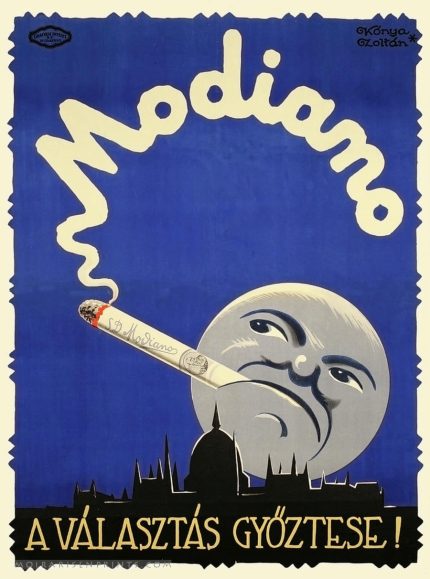On a personal note, I can’t stand smoking – but I have to admit that my adverse feelings towards everything related to cigarette smoke are somewhat appeased by the fact that many of the most brilliant advertisement posters of the early 1900s wouldn’t exist without the tobacco industry.
Modiano posters are definitely among these. The advertisement strategy of the Italian cigarette paper factory made Modiano a household name for decades in Europe, and even today the name sounds familiar to anybody with the slightest interest in advertisement design or collecting vintage posters.
The factory was founded in 1868 by Greek-Italian businessman Saul David Modiano (hence S. D.) in Trieste, Italy, and products of the brand became quickly popular because of their excellent quality. To keep up with the rapidly growing demand, the firm soon opened several new facilities in Italy and a branch factory in Hungary.
In Italy, Modiano was collaborating already with various leading local artists like Giuseppe Sigon, Argio Orell, Carlo Wostry, and Ugo Flumiani to create a strong brand appearance, but when the director of the Hungarian branch, Socrates Stavropulos started an advertising campaign in 1922 he had a new strategy on his mind. Instead of creating and maintaining a visually consistent company image he commissioned different Hungarian artists giving them a free hand to come up with their own design concepts.
From the early 20s to the late 30s, a dozen Hungarian designers – among them internationally recognized artists – took their turn and created advertising posters for Modiano. Bortnyik Sándor, Berény Róbert, Victor Vasarely (Vásárhelyi Győző), Irsai István, Kónya Zoltán, Bíró Mihály, Molnár C. Pál., Farkas Endre, Lányi Imre, ifj. Richter Aladár all had their distinct style that resulted in a row of posters telling different stories with different visual language, but with a lot of tongue-in-cheek humor, often referencing each other’s ideas in their designs.
Some of these posters became design icons – probably the most famous are Bortnyik’s Bauhaus style series and Berény’s Art Deco poster with the smoking man in black hat. A copy of the latter was sold for 37,500 GBP in 2015 at an auction at Christie’s.
Bortnyik had another, earlier series that is a fine example of the sense of humor incorporated in these posters. On his first design, there’s only a Modiano sign on a black and red background, with two circular heads set on top of the letter M, lighting their cigarettes from each other’s. On the second piece, there’s an advertising column with this same poster, together with an emblematic earlier design by Sigon (a man reading a magazine) and a poster by Kónya Zoltán, with a smoking figure looking up at them.
Kónya’s designs are my secret personal favorites, by the way :). He has a series of minimalistic posters featuring a Modiano sign shaped from cigarette smoke. On a 1922 edition, this cigarette is hanging from the mouth of a very grumpy full moon setting above the Hungarian Parliament Building. The caption says ‘A választás győztese/The winner of the election’, referencing the circumstances of the ongoing elections that year – a new election law was implemented, reducing the number of eligible voters by 25% in order to grant the victory for the governing party.
The Modiano brand design wasn’t limited to posters – book-markers, postcards, beer mats, counting cards, and similar items were also printed. Original Modiano posters are extremely rare, they surface only occasionally these days, but some of these smaller collectibles can still be found. One of the pictures below features a unique Art Deco-style figure made of wood, after a poster design by Engel Piroska.
The Hungarian branch of Modiano was sold in 1938, and although the name was changed to Diadal (Victory), the new brand adapted the popular and familiar design elements. A decade later, after WW II, the factory was permanently closed. The old, Italian Art Deco-style factory building is still standing…

Most of the posters above are available as print in our webstore.
















